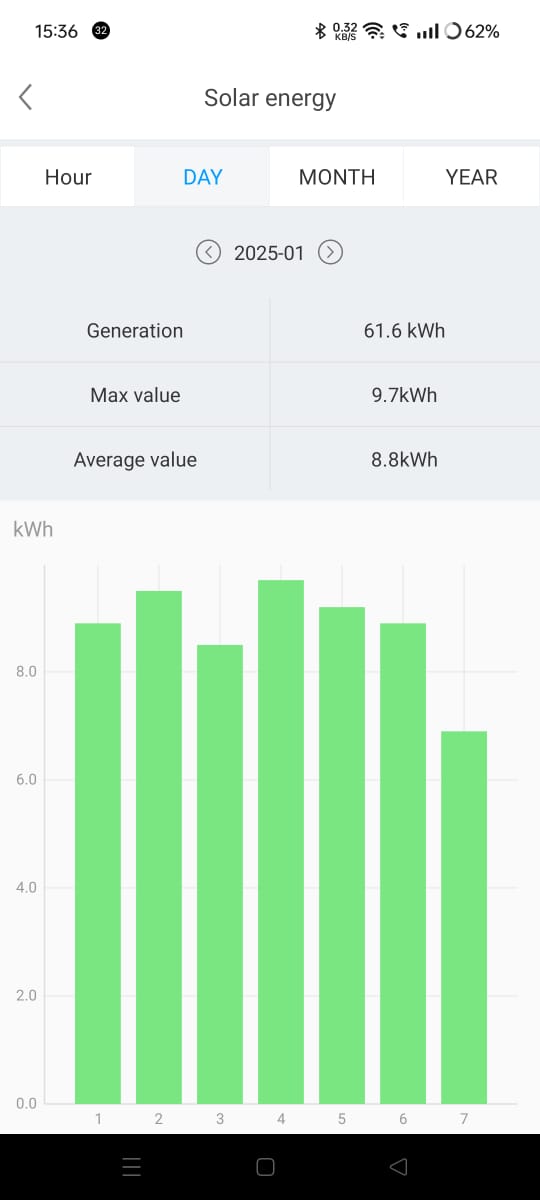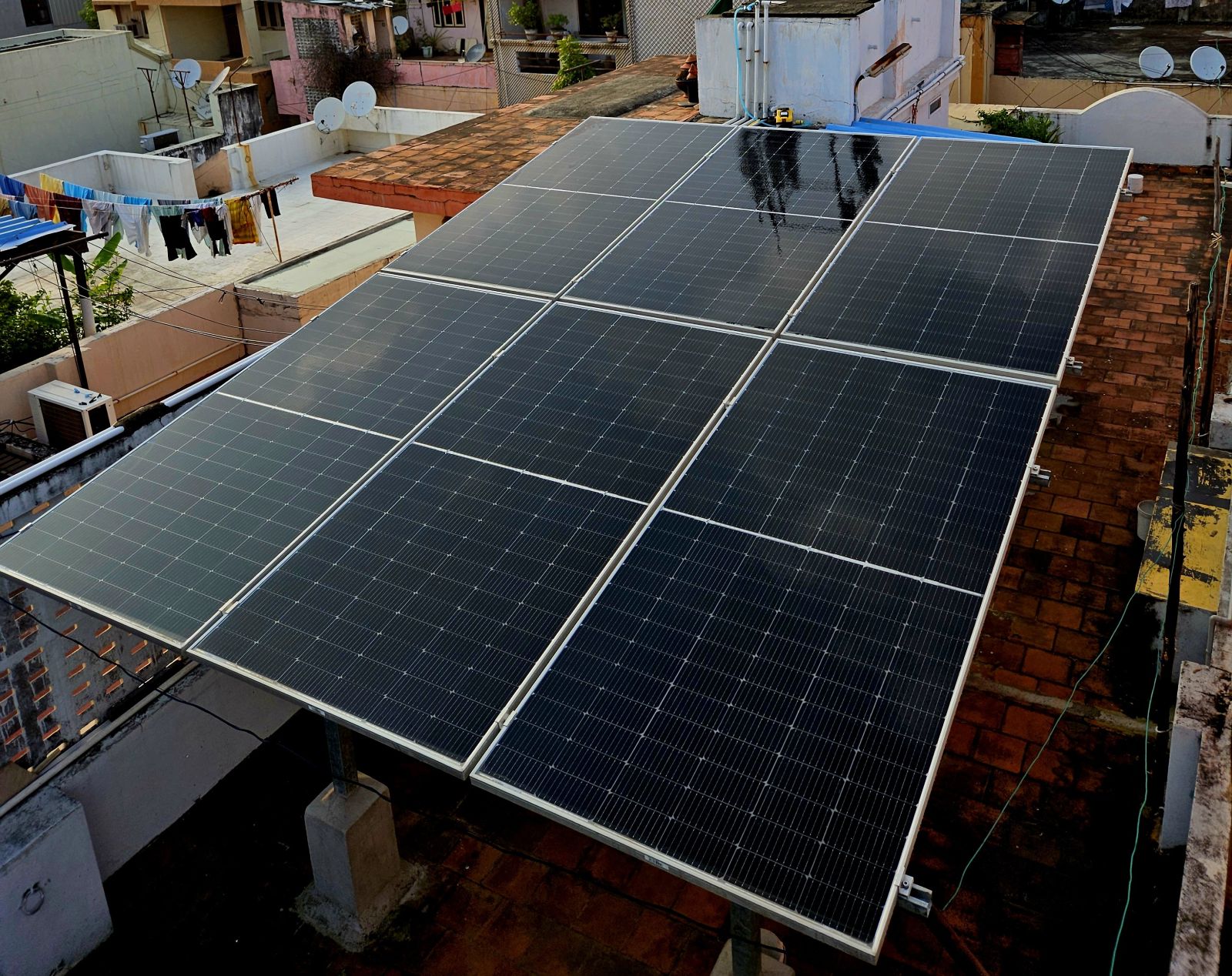
12 Years Under the Sun: Two Rooftop Solar Journeys
India’s rooftop solar PV landscape has undergone a remarkable transformation over the last decade, evolving from a niche option to a practical solution for homeowners across the country. In 2018, India’s rooftop solar capacity stood at a modest 1 GW. By 2024, it surged to almost 12 GW – a tenfold increase. Rooftop solar is playing a pivotal role in the Indian government’s target of establishing 500 GW of cumulative electric power from non-fossil fuel-based energy resources by 2030.
Through two personal experiences of installing household rooftop solar at different times in different cities, this blog sheds light on how shifting policies, challenges and opportunities have shaped adoption over time. One of us installed a modest 1 kWp system in Hyderabad in 2012, expanding it to 5 kWp in 2024. The other set up a 3 kWp system in Chennai in July 2024. These two journeys of solarization, over 12 years, highlight the progress of the sector and the evolution of the consumer experience. However, these accounts are highly context-specific and cannot represent the diversity of household solarization challenges across India.
What Drove My Decision To Go Solar
Rama: In a bid to do their bit for the environment, my in-laws installed a 1kWp PV system in 2012 in Hyderabad. At the time, they were the only two people living in the house. Since the household now has five people, we installed an additional 4kWp last year, which cost us as much as the 1kWp system did 12 years ago.
Harish: Solar is more than just an environmental choice; it makes economic sense now. Rising electricity tariffs in Tamil Nadu pushed me to take the leap towards reducing my bills over the long term. The PM Surya Ghar - Muft Bijli Yojana scheme now offers a subsidy of ₹30,000/- per kW for systems up to 2 kW and ₹78,000/- for 3 kWp or higher.
Experience of Setting up the Plant
Harish: I was pleasantly surprised by the efficiency of the setup. The National Portal for Rooftop Solar made everything incredibly simple — I could manage almost everything online, from selecting a certified vendor and securing electricity distribution company (DISCOM) approvals to setting up net metering. My vendor handled all coordination directly with the DISCOM for the approvals and site inspection, making the experience smooth and hassle-free. However, some last-mile issues remain with local DISCOM staff, and improving their understanding of rooftop solar PV systems could improve the consumer experience.
Rama: In 2012, there was just a smattering of solar panel vendors in Hyderabad, and reputed companies were unwilling to undertake small-scale residential projects. The company that set up the rooftop plant in our home in 2012, shut down in 2016, ending all support and impacting the life of our panels. However, the addition of the 4kWp in 2024 was very smooth, and thanks to the franchise model, I went ahead with a nationally recognized operator.
Impact of Net Metering and Tariff Structure on Savings
Rama: The 1kWp rooftop solar, installed in 2012, was a hybrid. The system supplied an inverter that powered the household, with only the excess power being transferred to the grid through net metering. However, the hybrid inverter had critical deficiencies. We removed the inverter and transferred all the generated power to the grid. With my current cumulative capacity of 5kWp, we have reduced our consumption to below 100 units a month. I am billed ₹3.10 per unit in electricity charges, and I am currently paying about ₹500 per month (including ₹150 in network charges). This also covers the cost of charging our electric car, which runs about 1,300 km a month.

Harish: The net metering mechanism has really boosted my savings. The power I export gets adjusted against my consumption, which brings my electricity bill down to almost nothing. On top of that, any surplus power I export gets credited to my account. States like Tamil Nadu have also introduced a yearly tariff inflation system linked to the Consumer Price Index. This means that as electricity tariffs increase over time, my savings actually grow, helping me recover my investment quicker in the long run.
Challenges Hampering Solar Uptake
Rama: Back in 2012, my family had to go through reams of paperwork to install the 1kWp plant. In the absence of subsidies, they paid a significant amount. In 2024, we added another 4 kWp but faced challenges with getting the state to verify the installation. There is no explicit ruling on the capacity expansion, hence the state interpreted it as being a part of existing installations.
Harish: WRI India’s 2018 working paper, Here Comes the Sun: Residential Consumers’ Experiences with Rooftop Solar PV in Five Indian Cities, highlighted the barriers to residential uptake such as the lack of clear installation information, supportive policies and customized financing options. Most of these concerns have now been addressed through the National Portal for Rooftop Solar, which centralizes all necessary information and simplifies the process for consumers. Jan Samarth, a digital platform that integrates government credit-linked schemes, also supports solar financing for residential consumers.
Would You Recommend Going Solar Today
Harish: With ease of installation, generous subsidies and seamless digital processes, rooftop solar photovoltaics (PVs) have never been more accessible. It is reassuring to know that my investment after the subsidy reimbursement will pay off quicker, thanks to supportive state and national policies. However, renters and apartment residents would face different challenges that need to be looked at.
Rama: My experience shows about 4kWp-5kWp is suitable for an average household of 4 to 5 people. In my case, expanding beyond that would have resulted in an extended payback period. Nonetheless, this completely depends on electricity consumption. For example, if you are using an electric pump, induction cooker, electric car, etc., then you are saving on fuel cost, that possibly compensates the cost of the panels, making it viable to expand.

Key Takeaways
For Vendors and Businesses
Businesses offer the bundling of the panel with the inverter as a ‘kitted’ package. While this appears convenient, it limits customization options for homeowners looking to expand their solar installations in the future.
For DISCOMs and Policymakers
The ceiling to qualify for financial assistance – 3 kWp for residences and 10 kWp for residential welfare associations – should be reassessed, as solar modules have become smaller and more efficient, allowing consumers to add more rooftop solar capacity with limited space. States should also consider adopting group net metering and virtual net metering policies, enabling residents in apartment complexes and multi-unit buildings to benefit collectively.
Waiving network charges (fees imposed for utilizing the electricity grid to import or export power) for rooftop solar consumers, at least until rooftop solar adoption reaches critical mass, could make the investment more attractive to new consumers. Lastly, state governments must support DISCOM staff in understanding the nuances of rooftop photovoltaic (PV) and its benefits.
For Consumers
It is important to recognize that India’s urbanization is increasingly characterized by apartment living and rental housing, where rooftop space ownership is limited. As such, the adoption of rooftop solar remains a challenge for many, requiring more innovative solutions, like group net metering or community solar models, to broaden access. Additionally, rental homeowners could consider installing solar systems to offer tenants discounted electricity rates.
Homeowners should carefully select a vendor based on their region’s specific needs and ensure that the installation cost aligns with the MNRE’s benchmark costs. Any customization, such as a high-rise solar structure, can increase the overall cost of the system and extend the payback period.
The real opportunity lies in recognizing the long-term financial and environmental benefits. By reducing electricity bills, enhancing property value, and contributing to India’s clean energy goals, consumers are not only making a smart investment but also supporting a greener, more sustainable future.